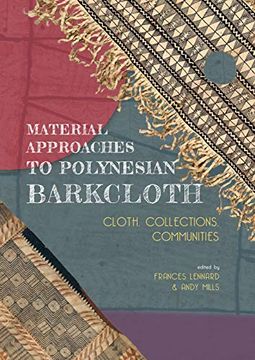Reseña del libro "Material Approaches to Polynesian Barkcloth: Cloth, Collections, Communities"
Barkcloth or tapa, a cloth made from the inner bark of trees, was widely used in place of woven cloth in the Pacific islands until the 19th century. A ubiquitous material, it was integral to the lives of islanders and used for clothing, furnishings and ritual artefacts. Material Approaches to Polynesian Barkcloth takes a new approach to the study of the history of this region through its barkcloth heritage, focusing on the plants themselves and surviving objects in historic collections. This object-focused approach has filled gaps in our understanding of the production and use of this material through an investigation of this unique fabric’s physical properties, transformation during manufacture and the regional history of its development in the 18th and 19th centuries.The book is the outcome of a research project which focused on three important collections of barkcloth at The Hunterian, University of Glasgow; Royal Botanic Gardens, Kew and the National Museum of Natural History, Smithsonian Institution. It also looks more widely at the value of barkcloth artefacts in museum collections for enhancing both contemporary practice and a wider appreciation of this remarkable fabric. The contributors include academics, curators, conservators and makers of barkcloth from Oceania and beyond, in an interdisciplinary study which draws together insights from object-based and textual reseach, fieldwork and tapa making, and information on the plants used to make fibres and colourants.This book will be of interest to tapa makers, museum professionals including curators and conservators; academics and students in the fields of anthropology, museum studies and conservation; museum visitors and anyone interested in finding out more about barkcloth.Table of ContentsAcknowledgementsImage creditsBiographiesIntroductionFrances LennardPart I: Tapa as Fabric: Bast and ColourantsThe procurement, cultural value and fabric characteristics of Polynesian tapa speciesAndy MillsPlant profile 1. Paper mulberry, Broussonetia papyriferaPlant profile 2. Breadfruit, Artocarpus altilisMark NesbittTechnical variation in historical Polynesian tapa manufactureAndy MillsBreadfruit tapa: not always second bestMichele Austin Dennehy, Jean Chapman Mason, Adrienne L. KaepplerPlant profile 3. Pacific banyan, Ficus prolixaPlant profile 4. Māmaki, Pipturus albidusMark NesbittA new perspective on understanding Hawaiian kapa-makingLisa Schattenburg-RaymondPolynesian tapa colourantsAndy Mills, Taoi Nooroa, Allan TuaraPlant profile 5. Beach hibiscus, Sea hibiscus, Hibiscus tiliaceusPlant profile 6. ‘Ākia, Wikstroemia uva-ursiMark NesbittHawaiian dyes and kapa pigments: a modern perspective and brief analysis of the historic recordLisa Schattenburg-RaymondPart II: Understanding Tapa in Time and PlaceTowards a regional chronology of Polynesian barkcloth manufactureAndy MillsLiving with tapa and the social life of ritual objectsAdrienne L. KaepplerPlant profile 7. ‘Oloa, Neraudia melastomifoliaPlant profile 8. Polynesian arrowroot, Tacca leontopetaloidesMark NesbittWest Polynesian dyes and decorations as cultural signaturesAdrienne L. Kaeppler‘A classification of Tongan ngatu’: change and stability in Tongan barkcloth forms since 1963Billie LythbergWhite for purity, brown for beautiful like us and black because it is awesomeFanny Wonu VeysPlant profile 9. Koka, Bischofia javanicaPlant profile 10. Candlenut, Aleurites moluccanaMark NesbittBarkcloth from the islands of Wallis (‘Uvea) and FutunaHélène GuiotBarkcloth in the Māori worldPatricia Te Arapo Wallace‘Ahu Sistas: reclaiming history, telling our storiesPauline Reynolds, Jean ClarksonPlant profile 11. Turmeric, Curcuma longaPlant profile 12. Noni, Morinda citrifoliaMark Nesbitt‘Tataki ʻe he Leá: Guided Language’Tui Emma Gillies, Sulieti Fieme’a BurrowsPart III: Tapa in Collections and the CommunityThe Hunterian’s Polynesian barkcloth collectionAndy MillsFrom maker to museum: Polynesian barkcloth at the Royal Botanic Gardens, KewMark Nesbitt, Brittany Curtis, Andy MillsPlant profile 13. Mati, Ficus tinctoriaPlant profile 14. Tou, Cordia subcordataPlant profile 15. Ironwood, Casuarina equisetifoliaMark NesbittSmithsonian Institution barkcloth collectionsAdrienne L. Kaeppler‘Holomua ka hana kapa’: a symposium on caring for kapa and kapa makers at the Bernice Pauahi Bishop Museum, December 2017Alice ChristopheFiji masi and the Auckland Museum Pacific Collection Access ProjectFuli Pereira, Leone Samu-TuiPlant profile 16. Malay apple, Syzygium malaccensePlant profile 17. Red mangrove, Rhizophora mangleMark NesbittShown to full advantage: conservation and mounting of barkcloth for display in the ‘Shifting Patterns: Pacific Barkcloth Clothing’ exhibition at the British MuseumMonique PullanConservation as part of ‘Situating Pacific Barkcloth in Time and Place’: improving preservation, enhancing access and sharing knowledgeFrances Lennard, Reggie Meredith Fitiao, Su’a Tupuola Uilisone Fitiao, Ruby Antonowicz-Behnan, Beth KnightAfterword: Polynesian barkcloth past, present, futureMark Nesbitt, Frances Lennard and Andy MillsBibliography

